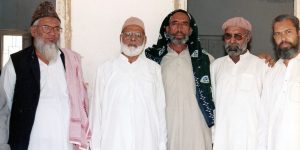Can You Organize a Million March?
It was July or August of 1996 when Qazi Hussain Ahmad asked me at some point, “Naimat sahib, can you organize a Million March?” “Yes, why not”, was my instant reply. Qazi sahib then said, “It should have more than a million people.” Soon after, I called an emergent meeting of the shura (decision-making body) and December 27 was set as the date for the march. Subsequently, committees were formed to finalize the routes, ensure participation of general public including women, initiate promotional campaign, and to take care of other aspects of the extraordinary public meeting. A major expenditure was obvious, so a Million March Fund was set up. Hangami (emergency) workers were also mobilized on the halqa (circle) and ilaqa (area) levels.
Political rallies and corner meetings outside the mosques and active participation of allied parties built a momentum in the city within days. Shahid Shamsi, Sarfaraz Ahmad, Ameen Sadiq, and others worked together to create vigorous party rhymes in the voice of Saleem Naz Barelvi and others. The leadership and workers of Shabab-e-Milli were at the forefront of the arrangements. On the evening of September 20, mohtarma Benazir Bhutto’s brother Mir Murtaza Bhutto was killed along with his close aides by police in a case of targeted killing. This tragic incident spread grief in the city. Murtaza was an open critique of his brother-in-law Asif Ali Zardari‘s style of politics, so fingers were pointed at him. A senior and informed journalist told me, “Khan sahib, a man’s killing by police personnel during his own sister’s rule proves that politics has no heart”.
The incident also temporarily affected the campaign for the march. On the day of the march, men and women began to arrive at the venue ahead of time through their respective routes. The pedestrian bridge at Tibet Center was turned into a stage. By 5pm, there was a sea of people there. The journalists present there commented: “You have brought a sea near the sea.” Qazi sahib arrived shortly afterwards. The program formally started after Asr prayers, but more people continued to join in. I was told that many convoys had to be stopped by the organizers because there was no more space for them to come forth. Other leaders from the JI center (Markaz) were stunned to see the mass. When Qazi sahib came to the rostrum, he praised Allah, thanked Him for His mercy, and said, “I had asked for a Million March; but it seems the entire city has arrived here.” We all felt really encouraged by his words.
The program concluded at Maghrib. I was talking to some people after the prayers when a man came and hugged me. He would cry and say, “Naimat sahib, with Allah’s blessings, the hard work has paid off.” The party workers were really happy. We held receptions in many areas after the historic gathering and the workers pledged to renew the organizational efforts. The march received a good coverage by mass media, too. This march will always be remembered as an important milestone in JI Karachi’s political history. The general elections were held on February 3, 1997, which the shura decided not to take part in. Several participants of the meeting opposed the idea, saying that poll boycott brings great harm for political parties. The majority voted in favor of the boycott and when a decision is made, it is the decision of every member of the party; that’s the essence of organization.
Qazi Hussain Ahmad wanted to see JI as a populist, religious, and welfare party. He would keep in constant contact with the heads and founders of Islamic movements from around the world. He had a great respect for the progress of the movements in countries like Turkey and Tunisia and wanted JI to work on the same parameters and include new people on a vast scale. Whenever we met him, he would say that the party won’t be able to do well in practical politics unless common men were in it, in fact in its ranks. He ordered to run a countrywide membership campaign and became actively involved in it. Seeing the interest of the party’s chief in the endeavor, the members and workers in the every city and town worked day and night and met a large number of people to convey JI’s message to them. The effects of this campaign, that went on from June 6 to July 15, 1997, can be gauged from the fact that the team led by nazim-e-ilaqa Syed Rasheed Ahmad in the city’s New Karachi neighborhood alone made 40,000 new members, who signed the forms. All other teams in other areas worked with the same zeal to achieve the objective.
|
|
![]()







